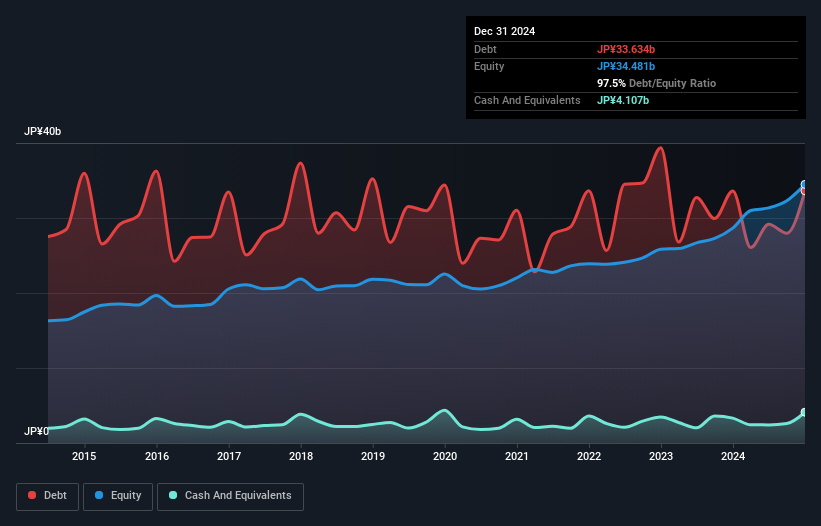- Japan
- /
- Food and Staples Retail
- /
- TSE:8041
Here's Why OUG Holdings (TSE:8041) Has A Meaningful Debt Burden
The external fund manager backed by Berkshire Hathaway's Charlie Munger, Li Lu, makes no bones about it when he says 'The biggest investment risk is not the volatility of prices, but whether you will suffer a permanent loss of capital.' So it seems the smart money knows that debt - which is usually involved in bankruptcies - is a very important factor, when you assess how risky a company is. We note that OUG Holdings Inc. (TSE:8041) does have debt on its balance sheet. But the real question is whether this debt is making the company risky.
Our free stock report includes 1 warning sign investors should be aware of before investing in OUG Holdings. Read for free now.What Risk Does Debt Bring?
Debt and other liabilities become risky for a business when it cannot easily fulfill those obligations, either with free cash flow or by raising capital at an attractive price. In the worst case scenario, a company can go bankrupt if it cannot pay its creditors. While that is not too common, we often do see indebted companies permanently diluting shareholders because lenders force them to raise capital at a distressed price. Of course, the upside of debt is that it often represents cheap capital, especially when it replaces dilution in a company with the ability to reinvest at high rates of return. The first step when considering a company's debt levels is to consider its cash and debt together.
What Is OUG Holdings's Net Debt?
As you can see below, OUG Holdings had JP¥33.6b of debt, at December 2024, which is about the same as the year before. You can click the chart for greater detail. On the flip side, it has JP¥4.11b in cash leading to net debt of about JP¥29.5b.

A Look At OUG Holdings' Liabilities
Zooming in on the latest balance sheet data, we can see that OUG Holdings had liabilities of JP¥71.1b due within 12 months and liabilities of JP¥8.67b due beyond that. Offsetting these obligations, it had cash of JP¥4.11b as well as receivables valued at JP¥48.6b due within 12 months. So it has liabilities totalling JP¥27.1b more than its cash and near-term receivables, combined.
The deficiency here weighs heavily on the JP¥16.3b company itself, as if a child were struggling under the weight of an enormous back-pack full of books, his sports gear, and a trumpet. So we'd watch its balance sheet closely, without a doubt. After all, OUG Holdings would likely require a major re-capitalisation if it had to pay its creditors today.
View our latest analysis for OUG Holdings
We measure a company's debt load relative to its earnings power by looking at its net debt divided by its earnings before interest, tax, depreciation, and amortization (EBITDA) and by calculating how easily its earnings before interest and tax (EBIT) cover its interest expense (interest cover). This way, we consider both the absolute quantum of the debt, as well as the interest rates paid on it.
As it happens OUG Holdings has a fairly concerning net debt to EBITDA ratio of 5.3 but very strong interest coverage of 190. This means that unless the company has access to very cheap debt, that interest expense will likely grow in the future. Importantly, OUG Holdings grew its EBIT by 49% over the last twelve months, and that growth will make it easier to handle its debt. The balance sheet is clearly the area to focus on when you are analysing debt. But it is OUG Holdings's earnings that will influence how the balance sheet holds up in the future. So when considering debt, it's definitely worth looking at the earnings trend. Click here for an interactive snapshot.
Finally, while the tax-man may adore accounting profits, lenders only accept cold hard cash. So we clearly need to look at whether that EBIT is leading to corresponding free cash flow. In the last three years, OUG Holdings's free cash flow amounted to 21% of its EBIT, less than we'd expect. That weak cash conversion makes it more difficult to handle indebtedness.
Our View
On the face of it, OUG Holdings's net debt to EBITDA left us tentative about the stock, and its level of total liabilities was no more enticing than the one empty restaurant on the busiest night of the year. But on the bright side, its interest cover is a good sign, and makes us more optimistic. Once we consider all the factors above, together, it seems to us that OUG Holdings's debt is making it a bit risky. That's not necessarily a bad thing, but we'd generally feel more comfortable with less leverage. The balance sheet is clearly the area to focus on when you are analysing debt. However, not all investment risk resides within the balance sheet - far from it. These risks can be hard to spot. Every company has them, and we've spotted 1 warning sign for OUG Holdings you should know about.
At the end of the day, it's often better to focus on companies that are free from net debt. You can access our special list of such companies (all with a track record of profit growth). It's free.
New: AI Stock Screener & Alerts
Our new AI Stock Screener scans the market every day to uncover opportunities.
• Dividend Powerhouses (3%+ Yield)
• Undervalued Small Caps with Insider Buying
• High growth Tech and AI Companies
Or build your own from over 50 metrics.
Have feedback on this article? Concerned about the content? Get in touch with us directly. Alternatively, email editorial-team (at) simplywallst.com.
This article by Simply Wall St is general in nature. We provide commentary based on historical data and analyst forecasts only using an unbiased methodology and our articles are not intended to be financial advice. It does not constitute a recommendation to buy or sell any stock, and does not take account of your objectives, or your financial situation. We aim to bring you long-term focused analysis driven by fundamental data. Note that our analysis may not factor in the latest price-sensitive company announcements or qualitative material. Simply Wall St has no position in any stocks mentioned.
About TSE:8041
OUG Holdings
Through its subsidiaries, engages in the wholesale of marine products in Japan.
Solid track record established dividend payer.
Market Insights
Community Narratives



